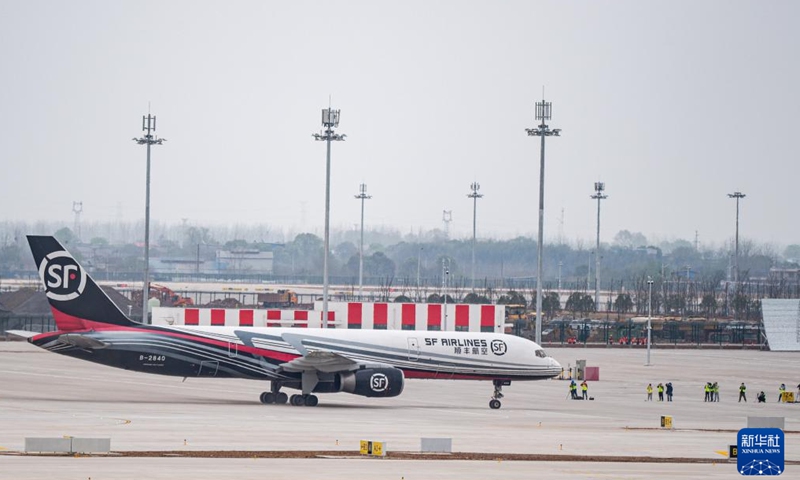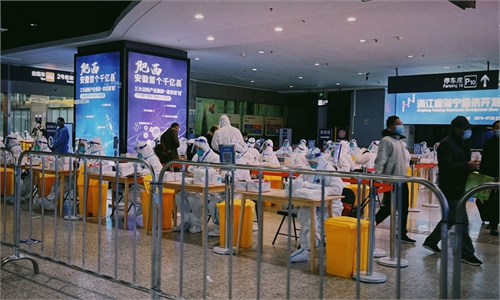
An air freighter taxis at the Ezhou Huahu Airport in Ezhou, central China's Hubei Province, March 19, 2022. The Ezhou Huahu Airport completed its flight-test of air freighter on Saturday. The airport is the country's first cargo airport, with the functional orientation of the air cargo hub and feeder airport for passenger transport. Photo:Xinhua
China’s transport sector has rebounded significantly over the past week after authorities announced 10 optimized measures against COVID-19 that eased restrictions on both cargo and passenger movements, according to indus-try players on Wednesday.
As local governments gradually rolled out measures to ease anti-COVID-19 restrictions, officials also optimized measures in the transportation sector. As a result, both cargo and passenger volumes will further increase, which will help boost the country’s overall economic recovery in the months ahead, analysts noted.
The country has scrapped closed-loop management re-quirements for freight vehicles and barred excessive anti-epidemic measures to restrict the cross-regional move-ment of such vehicles, according to a circular released by the State Council, the cabinet, on Friday.
The Ministry of Transport said that it is prohibited to block or close expressways, ordinary highways and navi-gation locks without authorization.
The ministry also noted that cross-regional passengers are no longer required to have their health codes checked or show nucleic acid test results if they travel by road, bus, ship or taxi.
Following the easing measures, freight transport respond-ed with a fast rebound, according to transportation data monitored by the State Council’s work group on smooth-ing logistics.
According to the data, 7.746 million trucks passed on ex-pressways nationwide on Tuesday, up 2.11 percent month-on-month. Cargo throughput at monitored ports rose 1.6 percent on a monthly basis, while the number of civil aviation cargo flights rose by 24 percent month-on-month to 671.
China Southern Air Logistics told the Global Times on Wednesday that it is increasing the number of cargo flights to Europe and the Americas, and optimized the route from Guangzhou to London via stopped at Shang-hai. The carrier said it planned to open a cargo route from Pudong-Los Angeles-Mexico in January 2023.
Wang Zhengbo, chairman of TWT, a Guangxi-based cross-border trade and supply chain operator, told the Global Times that he sensed many changes in road freight transport recently, including the removal of many nucleic acid test checkpoints. Also, at highway ports, drivers are no longer required to stay in quarantine hotels for closed-loop management, he said.
Wang noted that the current model of non-contact, drop-and-pull transport at ports might also change shortly to make transportation more convenient.
“As a result of easing anti-COVID restrictions for freight transport, the volume of our freight transport has in-creased to some extent, but I figure the changes will be more evident in about half a month or one month,” he said.
TWT mostly ships goods to markets in the Association of Southeast Asian Nations and some economies along the Belt and Road Initiative route.
Data released by Baidu Map showed that passenger flows at key transportation hubs on Monday rose by 34 percent on a yearly basis, while tourist flows at major tourism sites rose by 41.3 percent.
Experts said that the recent logistics rebound has been very fast and sensitive to policy changes, which paves the way for a further economic rebound.
“China’s logistics industry could grow by about three to five percent in 2023, which is not a particularly high rate but still a good situation, considering that freight trans-port has remained flat for the past several years as a result of COVID-19,” Tian Yun, a veteran economist, told the Global Times.
Smooth freight transport could provide solid support for economic sectors such as trade and consumption, and fur-ther support the overall economic recovery.
Tian Yuan, a deputy research fellow at the Chinese Acad-emy of International Trade and Economic Cooperation, said that the trend of recovery in logistics has begun to take shape, and judging from the direction of anti-COVID policies, the logistics industry will continue to improve.
“Based on certain epidemiologists’ forecasts that people’s lives could return to pre-epidemic levels in the first half of next year, logistics should also recover to a normal sit-uation around mid-2023,” Tian Yuan said.



